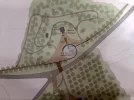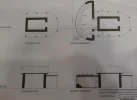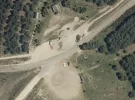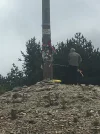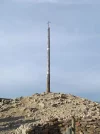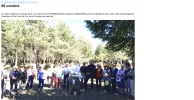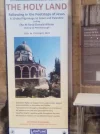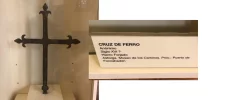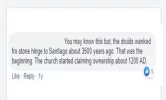The thing is why Ferro became the "official name" in a non-Galician speaking area like Foncebadon where the word is Fierro/Hierro.
That's the question.
It has multiple "official" names in multiple Iberian languages.

es.wikipedia.org
La
Cruz de Hierro (castellano)
(Cruz de Ferro, denominación usada por organismos oficiales, (
https://web.archive.org/web/2015022...ndes-rutas/camino-santiago-frances/foncebadon : Desde Rabanal hasta aquí se extiende una amplia zona montañosa de bosques y prados. Foncebadón es lugar prácticamente despoblado. Fue el eremita Gaucelmo su fundador y quien entre los siglos XI y XII levantó el hospital de peregrinos.
Además, en esta localidad se encuentra la
Cruz de Ferro.)
en
gallego (
https://emigracion.xunta.gal/actual...alicia-ponferrada-organiza-romaria-cruz-ferro -- Ponferrada, 21 de xullo de 2014.
Como vén sendo habitual o Centro Galicia en Ponferrada organiza a Romaría da
Cruz de Ferro, festa declarada de "Interese turístico Provincial" en conmemoración ao Día de Galicia, este ano farase o domingo 27 de Xullo. Desenvólvese na Paraxe da Cruz de Ferro, pertencente ao Concello de Santa Colomba de Somoza. Así mesmo enxalzaremos o Camiño de Santiago e á figura do Peregrino no seu paso pola
Cruz de Ferro. ),
Cruz de Fierro en
leonés (
https://web.archive.org/web/2010050...riodeleon.es/noticias/noticia.asp?pkid=524310 -- El gran novelista Enrique Gil y Carrasco, nombre clave del romanticismo español, la nombraba
Cruz de Fierro; hasta los años ochenta, dos carteles situados al pie de ella (uno de ellos en francés) exhibían los rótulos de
Cruz de Fierro y
Croix de Fierro ; y, en fin, los paisanos de los pueblos cercanos, cuando se les pregunta, se refieren a ella como «
la cruz de fierru».
Y, sin embargo, el nombre que más se ha popularizado -”quizá por influencia de los segadores gallegos que iban camino de Campos-” ha sido «
cruz de Ferro», cuando la forma
ferro , sin diptongo, aparece más adelante, una vez cruzado el río Cúa.
Fierro, fierru es la forma leonesa típica para la palabra hierro en los montes maragatos y altobercianos.) )
es un
crucero que se halla en el punto más alto del
Camino de Santiago Francés, a unos 1500 msnm. Está situado entre las localidades
españolas de
Foncebadón y
Manjarín, pertenecientes al municipio de
Santa Colomba de Somoza (
León).
---
It is named "
Cruz de Ferro" in Gallego ; and in the official Camino documentation, because the Cathedral and the various primary offices concerned with the Camino are in
Galicia.
Locals who live up there call it "
la cruz de fierru".
Other Leonese call it "
Cruz de Fierro".
Castilians, "
Cruz de Hierro".
Catalan : (
https://cicloturisme100x100.blogspot.com/2015/05/cami-catala-per-st-joan-de-la-penya-9.html -- Paro a dinar i segueixo cap a la comarca de la Maragateria. Castrillo dels Polvazares, Pedredo, Santa Colomba de Somoza, Rabanal del Camino. Havia pensat de quedar a dormir aquí, però encara tinc forces i temps per pujar el coll de la
Cruz de Ferro, segueixo.)
French : (
https://www.chemin-compostelle.fr/le-camino-frances-culmine-a-la-cruz-de-ferro/ -- Alors cette
croix de fer, qu’on peut appeler «
Cruz de Ferro » en galicien, «
Cruz de Hierro » en castillan, ou bien encore «
Cruz de Fierro » en léonais, est-elle pour vous un souvenir marquant de votre pèlerinage, ou une irrésistible invitation au voyage ? )
English : (
https://yourwaytosantiago.com/the-ritual-at-the-iron-cross/ --
The Iron Cross, or “Cruz de Fierro”, is a monument located at the highest point of the French Way, in the
Camino de Santiago. It is located in Mount Irago, between the Spanish cities of Foncebadon and Manjarin, within the Leon Mountains.
On a knoll of stones deposited by the pilgrims, stands an oak trunk about 5 meters high, topped by a simple iron cross from which the monument takes its name.)
---
Look, this really is completely non-problematic. First of all, it is not even a place name, it is a particular monument, that everyone can refer to in their own language ; the tendency of English to use the "proper" foreign names for things doesn't much exist in other languages (even though the English traditionally use for example "
Marseilles" and "
Lyons" instead of Marseille and Lyon).
Very simply, it can be referred to in multiple different ways in multiple different languages -- get over it !!

 astorgaredaccion.com
astorgaredaccion.com





